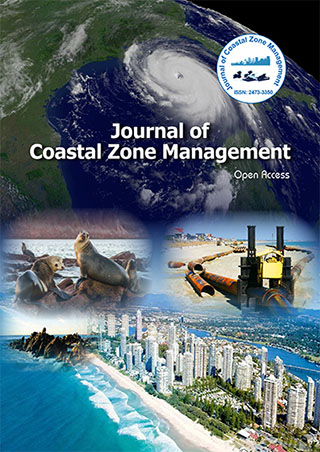Indexed In
- SafetyLit
- RefSeek
- Hamdard University
- EBSCO A-Z
- OCLC- WorldCat
- Publons
Useful Links
Share This Page
Journal Flyer

Open Access Journals
- Agri and Aquaculture
- Biochemistry
- Bioinformatics & Systems Biology
- Business & Management
- Chemistry
- Clinical Sciences
- Engineering
- Food & Nutrition
- General Science
- Genetics & Molecular Biology
- Immunology & Microbiology
- Medical Sciences
- Neuroscience & Psychology
- Nursing & Health Care
- Pharmaceutical Sciences
Commentary - (2024) Volume 27, Issue 6
Marine Spatial Strategies: Economic Growth, Conservation and Environmental Sustainability
Maken Anthony*Received: 28-Oct-2024, Manuscript No. JCZM-24-27587; Editor assigned: 30-Oct-2024, Pre QC No. JCZM-24-27587 (PQ); Reviewed: 15-Nov-2024, QC No. JCZM-24-27587; Revised: 22-Nov-2024, Manuscript No. JCZM-24-27587 (R); Published: 29-Nov-2024, DOI: 10.35248/2473-3350.24.27.659
Description
Marine Spatial Planning (MSP) has emerged as a major tool for managing the competing interests of conservation and economic development in coastal and marine environments. As human activities like fishing, tourism, offshore energy development and shipping increase, the pressure on marine ecosystems grows. MSP provides a framework for organizing the use of marine space to minimize conflicts, promote sustainable development and protect marine ecosystems. This approach is increasingly seen as essential for achieving a balance between ecological conservation and the economic needs of coastal communities.
The importance of marine spatial planning
Marine ecosystems are home to a diverse range of species and habitats, many of which are under threat from overfishing, pollution and climate change. At the same time, the ocean is a valuable resource for economic activities such as fisheries, tourism and energy production. Without proper management, the demands of these industries can lead to environmental degradation, threatening the very ecosystems that support them.
Marine spatial planning addresses this challenge by providing a systematic approach to managing the use of marine areas. MSP involves the identification of different zones within marine environments, each designated for specific activities, such as conservation, tourism, or industrial use. By allocating space for various activities based on ecological and economic data, MSP helps reduce conflicts between the groups and ensures that marine resources are used in a sustainable way.
The core principles of MSP include ecosystem-based management, multi-group participation and adaptability. Ecosystem-based management ensures that the planning process takes into account the health and sustainability of the entire ecosystem, rather than focusing on individual species or sectors. This holistic approach is significant for maintaining the resilience of marine environments in the face of climate change and other stressors.
Multi-groups participation is another critical aspect of MSP. The planning process involves input from a wide range of interested groups, including government agencies, local communities, industry representatives and environmental organizations. By including diverse perspectives, MSP aims to create plans that are equitable and supported by all parties.
Adaptability is significant for the success of MSP. Marine environments are dynamic and can change rapidly due to factors such as climate change, technological advances and economic shifts. As a result, MSP plans must be flexible enough to accommodate new information and changing conditions.
In response, several countries bordering the North Sea, including the United Kingdom, Germany and the Netherlands, have implemented MSP to manage these competing interests. By designating specific areas for offshore wind farms, shipping lanes and fishing zones, MSP has helped reduce conflicts and promote the sustainable use of marine resources. Moreover, the inclusion of Marine Protected Areas (MPAs) within the MSP framework has ensured the conservation of critical habitats and species.
While MSP offers many benefits, there are also challenges to its implementation. One significant obstacle is the availability of accurate and up-to-date data on marine ecosystems and human activities. Comprehensive mapping of marine environments requires significant resources and gaps in data can limit the effectiveness of MSP.
Additionally, MSP must balance the interests of various groups, which can be difficult when economic priorities conflict with conservation goals. Achieving this balance requires strong governance, clear communication and, in some cases, compromise.
Despite these challenges, MSP presents a significant opportunity for sustainable development in marine environments. By integrating conservation and economic growth, MSP can help protect marine ecosystems while supporting the livelihoods of coastal communities.
Marine spatial planning is a powerful tool for balancing conservation and economic growth in coastal and marine environments. By providing a framework for managing the competing interests of different industries, MSP helps protect marine ecosystems while promoting sustainable development. The success of MSP in regions like the North Sea demonstrates its important to reduce conflicts, conserve biodiversity and support economic activities. As the pressures on marine environments continue to grow, the adoption of MSP will be significant for ensuring the long-term health of our oceans and the communities that depend on them.
Citation: Anthony M (2024). Marine Spatial Strategies: Economic Growth, Conservation and Environmental Sustainability. J Coast Zone Manag. 27:659.
Copyright: © 2024 Anthony M. This is an open-access article distributed under the terms of the Creative Commons Attribution License, which permits unrestricted use, distribution, and reproduction in any medium, provided the original author and source are credited.
